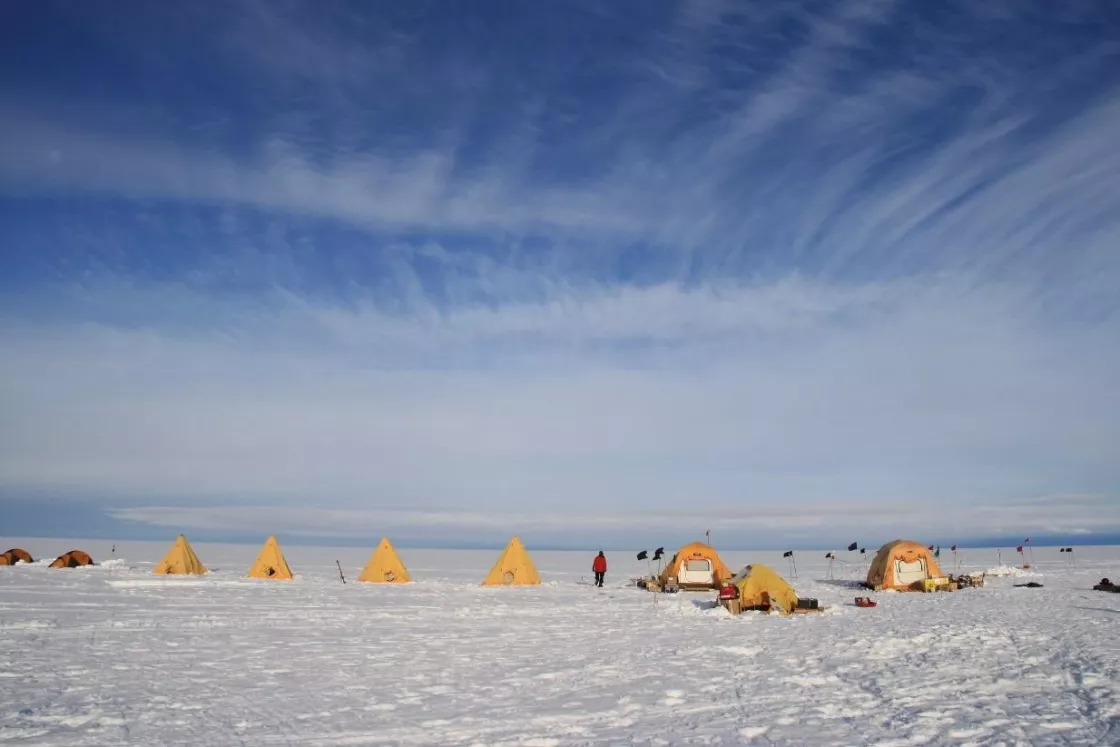Thwaites Glacier is one of the fastest-retreating glaciers in Antarctica. This colossal glacier covers an area roughly the size of Florida or Great Britain in West Antarctica and it is rapidly losing ice to the ocean in response to climate change and changes in ocean circulation. Thwaites Glacier is already a major contributor to global sea level rise; it loses more than 50 billion tons of ice to the ocean each year, equaling about four percent of annual sea level rise. Since the 1990s, the amount of ice flowing out of the region has nearly doubled. If this rate of ice loss continues to accelerate as scientists predict, it could lead to a run-away collapse of the glacier. Global sea levels could increase up to 65 centimeters, or two feet, in the coming centuries as a result, putting coastal cities and communities around the world at risk.
The International Thwaites Glacier Collaboration (ITGC), a five-year, $50 million partnership between the US National Science Foundation (NSF) and the UK Natural Environment Research Council (NERC), was formed in 2018 in response to these predictions. The collaboration seeks to answer two imperative questions about Thwaites Glacier: how much could it contribute to sea level rise, and how soon could this happen? ITGC consists of eight research projects, which focus on different aspects of the glacier and its environment. More than 150 scientists and students from around the world are studying Thwaites Glacier and its adjacent ocean region as part of ITGC to contribute data and information to understand the behavior of the glacier and what its future could look like to better inform the general public, science community, and policymakers.
NSIDC plays several supporting roles in ITGC, including software development and data management for one of the ITGC projects and a broader coordination role through co-hosting the US Science Coordination Office (SCO) in partnership with the Cooperative Institute for Research in the Environmental Sciences (CIRES) and the Lamont-Doherty Earth Observatory of Columbia University. Ted Scambos, an alumni NSIDC scientist who is now at CIRES, leads the US SCO and Betsy Sheffield of NSIDC leads communications for the US SCO. Scambos is also a co-investigator on the Thwaites-Amundsen Regional Survey and Network Integrating Atmosphere-Ice-Ocean Processes project, which seeks to understand how atmospheric and oceanic processes influence the behavior of Thwaites Glacier and nearby Dotson Ice Shelf, and Bruce Wallin of NSIDC works programs software and handles data management for this project.
Coordinating across projects and organizations
Because ITGC is such a massive undertaking, the program requires a great deal of coordination across projects and organizations. This is where the SCO comes in. The US SCO, in coordination with counterparts in the UK, brings the eight ITGC research projects together under a shared vision and plan. It also coordinates science to maximize the effectiveness of the research teams and handles media outreach, web content, and education products for the program.
When ITGC began, information about the different research projects and those involved was dispersed. The SCO worked to consolidate this information across research teams, first reaching out to each research project principal investigator to gather the names and information of scientists and students working on their projects. From there, the SCO set up channels to allow easy communication across these research projects by developing the ITGC website, setting up mailing lists and Slack channels, and coordinating international planning meetings.
Communicating science
In addition to leading internal communications for the US, outreach has been a huge priority for the SCO. The SCO team proactively reaches out to media to share information about ITGC and the research and data that have come from the collaboration, works with researchers and students to communicate ITGC science through blog posts, videos, and social media posts, and even connects schools with ITGC scientists for learning opportunities during Antarctica Week.
Antarctica Week occurs during the first week in December in commemoration of when the Antarctic Treaty, which was ratified in 1959 and regulates international relations in regard to Antarctica. During Antarctica Week, ITGC scientists speak with students in classrooms or online about what it is like to live and work in Antarctica and why they are studying Thwaites Glacier. In 2020, Antarctica Week went fully digital in response to the coronavirus disease (COVID-19) pandemic, and anyone who was interested was welcome to listen in.
An international research effort
While the US and UK lead ITGC, it is truly an international effort, with significant research contributions coming from several other countries around the world, including South Korea, Germany, and Sweden. ITGC is funded by the UK Natural Environment Research Council and US National Science Foundation. Data sets from ITGC research will be available at the US Antarctic Program Data Center and UK British Antarctic Survey Archives Service. Work on the project is expected to conclude in 2025 and 2026.
Project timeline
- 2018: The International Thwaites Glacier Collaboration began
- 2026: ITGC will conclude
